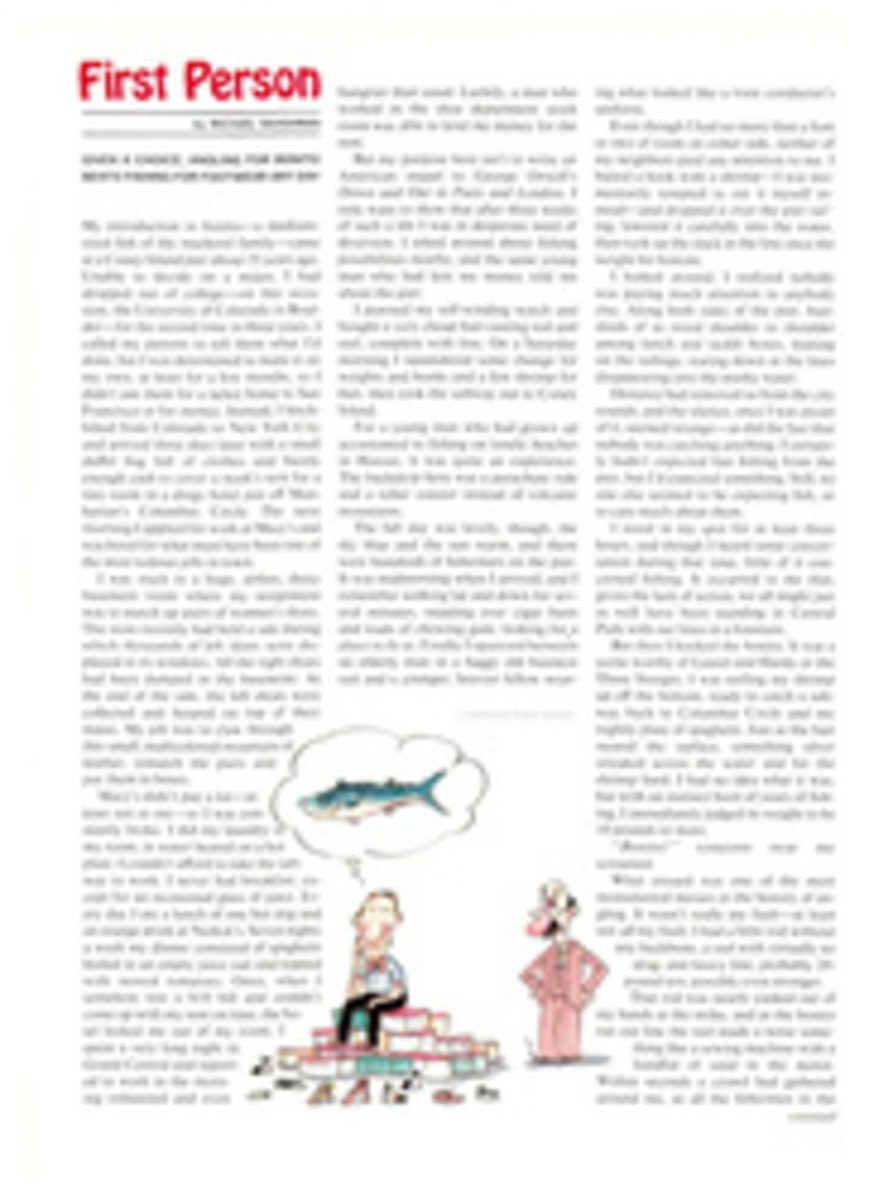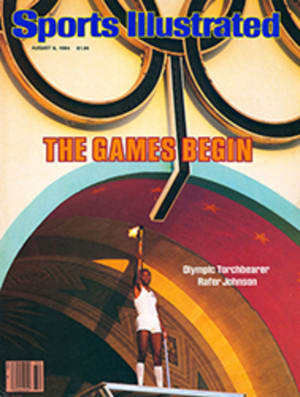
GIVEN A CHOICE, ANGLING FOR BONITO BEATS FISHING FOR FOOTWEAR ANY DAY
My introduction to bonito—a medium-sized fish of the mackerel family—came at a Coney Island pier about 25 years ago. Unable to decide on a major, I had dropped out of college—on this occasion, the University of Colorado in Boulder—for the second time in three years. I called my parents to tell them what I'd done, but I was determined to make it on my own, at least for a few months, so I didn't ask them for a ticket home to San Francisco or for money. Instead, I hitchhiked from Colorado to New York City and arrived three days later with a small duffel bag full of clothes and barely enough cash to cover a week's rent for a tiny room in a dingy hotel just off Manhattan's Columbus Circle. The next morning I applied for work at Macy's and was hired for what must have been one of the most tedious jobs in town.
I was stuck in a huge, airless, dusty basement room where my assignment was to match up pairs of women's shoes. The store recently had held a sale during which thousands of left shoes were displayed in its windows. All the right shoes had been dumped in the basement. At the end of the sale, the left shoes were collected and heaped on top of their mates. My job was to claw through this small, multicolored mountain of leather, rematch the pairs and put them in boxes.
Macy's didn't pay a lot—at least not to me—so I was constantly broke. I did my laundry in my room, in water heated on a hot plate. I couldn't afford to take the subway to work. I never had breakfast, except for an occasional glass of juice. Every day I ate a lunch of one hot dog and an orange drink at Nedick's. Seven nights a week my dinner consisted of spaghetti boiled in an empty juice can and topped with stewed tomatoes. Once, when somehow lost a $10 bill and couldn't come up with my rent on time, the hotel locked me out of my room. I spent a very long night in Grand Central and reported to work in the morning exhausted and even hungrier than usual. Luckily, a man who worked in the shoe department stock room was able to lend me money for the rent.
But my purpose here isn't to write an American sequel to George Orwell's Down and Out in Paris and London. I only want to show that after three weeks of such a life I was in desperate need of diversion. I asked around about fishing possibilities nearby, and the same young man who had lent me money told me about the pier.
I pawned my self-winding watch and bought a very cheap bait-casting rod and reel, complete with line. On a Saturday morning I squandered some change for weights and hooks and a few shrimp for bait, then took the subway out to Coney Island.
For a young man who had grown up accustomed to fishing on lonely beaches in Hawaii, it was quite an experience. The backdrop here was a parachute ride and a roller coaster instead of volcanic mountains.
The fall day was lovely, though, the sky blue and the sun warm, and there were hundreds of fishermen on the pier. It was midmorning when I arrived, and I remember walking up and down for several minutes, stepping over cigar butts and wads of chewing gum, looking for a place to fit in. Finally I squeezed between an elderly man in a baggy old business suit and a younger, heavier fellow wearing what looked like a train conductor's uniform.
Even though I had no more than a foot or two of room on either side, neither of my neighbors paid any attention to me. I baited a hook with a shrimp—I was momentarily tempted to eat it myself instead—and dropped it over the pier railing. lowered it carefully into the water, then took up the slack in the line once the weight hit bottom.
I looked around. I realized nobody was paying much attention to anybody else. Along both sides of the pier, hundreds of us stood shoulder to shoulder among lunch and tackle boxes, leaning on the railings, staring down at the lines disappearing into the murky water.
Distance had removed us from the city sounds, and the silence, once I was aware of it, seemed strange—as did the fact that nobody was catching anything. I certainly hadn't expected fast fishing from the pier, but I'd expected something. Still, no one else seemed to be expecting fish, or to care much about them.
I stood in my spot for at least three hours, and though I heard some conversation during that time, little of it concerned fishing. It occurred to me that, given the lack of action, we all might just as well have been standing in Central Park with our lines in a fountain.
But then I hooked the bonito. It was a scene worthy of Laurel and Hardy or the Three Stooges. I was reeling my shrimp up off the bottom, ready to catch a subway back to Columbus Circle and my nightly plate of spaghetti. Just as the bait neared the surface, something silver streaked across the water and hit the shrimp hard. I had no idea what it was, but with an instinct born of years of fishing, I immediately judged its weight to be 10 pounds or more.
"Bonito!" someone near me screamed.
What ensued was one of the most monumental messes in the history of angling. It wasn't really my fault—at least not all my fault. I had a little rod without any backbone, a reel with virtually no drag, and heavy line, probably 20-pound test, possibly even stronger.
That rod was nearly yanked out of my hands at the strike, and as the bonito ran out line the reel made a noise something like a sewing machine with a handful of sand in the motor. Within seconds a crowd had gathered around me, as all the fishermen in the area squeezed in and peered over the railing to get a look.
Meanwhile, the bonito went crazy. Before I had even begun to collect my wits, the line running off the reel had back-lashed into a gigantic snarl of monofilament, and the line in the water had tangled with those of at least 20 other fishermen on both sides of me.
Understandably, that brought on a chorus of suggestions, complaints, accusations and curses from the crowd that had been so docile for hours:
"What the hell is this?"
"Hey, dammit!"
"Who hooked the goddam fish?"
"It's a bonito! Bonito! Tighten the drag!"
"I've never seen one of those."
"Loosen the drag!" yelled the old gentleman in the baggy business suit.
Fishermen were jostling me, yelling at me and at each other, yanking at their own rods, trying to reel as they lifted their rods over or passed them under the rods of their neighbors in futile attempts to make some sense of the huge tangle of lines.
"Outta my way!"
"Outta mine!"
'What the hell's a bonito doing here?"
"Who hooked the damn thing?"
"Watch it, creep!"
"What's a bonito?"
There was so much confusion that no one knew who was doing what, or why. I had become about as anonymous as a man in the Times Square crush on New Year's Eve—so I simply dropped my rod, elbowed and squirmed my way out of the crowd and walked quickly away.
And, I'll admit, I was laughing. When I stopped and looked back from the safe distance of 100 yards and saw the knot of people still frantically milling on the pier, I nearly had to double up—and I realized that it was the first time I'd found anything genuinely funny since arriving in New York.
On Monday morning I was back in Macy's basement rifling through footwear. Every hour or two my boss would come by to see that I was working. He'd open a couple of boxes at random and make sure the shoes in them were correctly matched. Until the end of that week, when I finally completed the job, whenever he came by I was either smiling or chuckling to myself, and I'm sure he thought I was half crazy or simpleminded—but I was thinking about the bonito I'd hooked off the Coney Island pier.
I finally finished college, and I made it a point to learn about bonitos, too. I've been fishing for them ever since and have hooked them off Florida, California and Mexico. They've become my favorite saltwater game fish.
It's true that bonitos don't get much publicity, and there are two clear, if silly, reasons for this. First, they're dark-fleshed and not especially good to eat—but, of course, that matters not at all when you fish for sport. Second, they aren't very large—anything over 10 pounds is exceptional—but 10 pounds of bonito is as strong as 10 pounds of any fish that swims. Hooked on light fly or spinning gear, they can do things difficult to believe.
In Spanish bonito means pretty. And bonitos are that, with bodies as streamlined as torpedoes, blue backs striped longitudinally with black, silver bellies and scythelike tails.
They often travel in large schools and will strike at virtually anything that moves quickly through the water. They are found along both coasts, though they're less common in colder northern waters, which explains why my first catch was unfamiliar to so many of the fishermen on the pier that day.
Every time I hook one, I remember my first bonito at Coney Island, which I'd never have encountered had it not been for a pile of women's shoes in Macy's basement—and every time I remember, it makes me smile.
ILLUSTRATION
PATRICK McDONNELL
ILLUSTRATION

